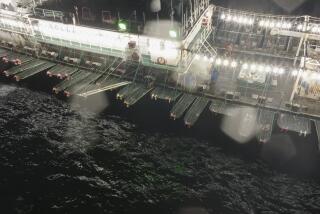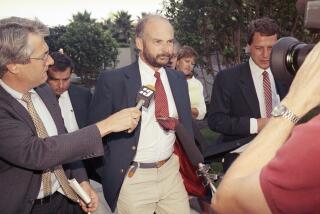Dispute Points Up Difficulty of Governing Oil Tankers : Commerce: Officials found a ship had engine trouble and dubious logs. But they couldn’t keep it from sailing.
Four days before Christmas, as the tanker Bertina prepared to leave British Columbia with a cargo of Canadian crude oil, the captain drafted an urgent message to its Norwegian owners.
In heavy seas off the Pacific Coast the previous week, the captain wrote, the Bertina’s main engine had been shut down repeatedly, leaving the ship powerless and drifting--one cause of previous tanker catastrophes. Similar problems had haunted the Bertina for months.
The situation did not end in disaster and might have remained a wharf-side rumor if someone had not accidentally dialed the wrong fax machine, sending the captain’s candid message to the San Francisco oil company that had chartered the vessel. There, company officials read it in horror.
The saga of the Bertina offers a rare glimpse into the world of foreign oil tankers maneuvering through Southern California waters.
By most measures, the rules governing tanker commerce have been greatly strengthened since the Exxon Valdez hit Alaska’s Bligh Reef four years ago. But how well those rules are applied is another matter.
The Bertina plies the world’s tanker lanes in a workaday reality in which international standards have yet to be reconciled with stubborn maritime traditions.
Built 11 years ago by respected Japanese shipbuilders, the Bertina is no aging rust bucket. It has a good record with insurers and hires experienced captains and crew. The New York-based Tanker Advisory Center, which rates the safety of the world’s oil tanker fleets, gives the Bertina a 4 on a scale with 5 as the highest rank.
The vessel’s Norwegian owners say American authorities and the charter company have made much ado about nothing. “A hurricane in a glass of water . . . no big deal,” said Erling Boroe, director of chartering and operations for Bergshav A.S. of Grimstad, Norway.
But the Coast Guard and Chemoil Corp., the ship’s San Francisco charterers, say the owners and crew tried to hide potentially disastrous problems.
On the December day that the misdirected fax arrived, Chemoil executives knew that the Bertina had been unaccountably late sailing from Los Angeles to Vancouver. Now they knew why.
Capt. Aniket Shankar Kelkar described his first voyage on the Bertina:
The main engine was “stopped frequently,” every 15 hours for days, because of clogged oil filters. An automatic warning system was also malfunctioning, causing the main engine to shut down “without any alarm.” An engineer’s report from an earlier voyage showed that “all above problems have been there from last six to eight months.”
Chemoil officials also learned that none of these events had been entered in the Bertina’s official logs--as required by international convention and American law.
Besides the cost of delays, the Chemoil executives knew that they could be liable for millions of dollars in damages in the event of an oil spill. And within weeks the Bertina would be returning to Long Beach with another cargo of fuel oil.
Chemoil warned the Coast Guard’s captain of the port, who had already heard of the Bertina’s troubles. When the ship reached the harbor breakwater Feb. 22, Chemoil and the Coast Guard dispatched tugs to escort the ship to its berth.
First aboard the ship were investigators hired by Chemoil, which had good reason to worry about the Bertina’s safety.
In 1991, a barge from a Chemoil subsidiary, Links Marine Inc., was pumping fuel oil into a South Korean merchant vessel, the Sammi Superstars, when the tanks overflowed. The largest oil spill in Los Angeles harbor cost $18 million to clean up. It also resulted in the first felony charges to be filed under California’s Oil Spill Prevention and Response Act, passed in 1990 after the Huntington Beach oil spill earlier that year. Criminal charges are pending against Links Marine.
The Chemoil team included David L. Grant and Paul Larson, two former Coast Guard officers now with Admiralty Marine Surveyors Inc., a technical services consultancy in Wilmington. Larson had spent a year investigating the Exxon Valdez accident. Also on hand was Bill Kelley, a Seattle maritime consultant with 25 years of experience as a tanker engineer.
The team spent nearly two days prowling the engine room, scrutinizing ship records and interviewing the captain and crew. No one on the ship knew that Chemoil had received what Larson called the “mystery fax.”
And by now, they had more than the mystery fax to make them suspicious.
In an earlier look at the Bertina’s logbooks by a Chemoil agent in Panama, no engine stops on the December voyage had been noted, said Dennis Kelly, a Chemoil attorney. Instead, the agent found “numerous entries . . . that were whited out,” Kelly said.
Standard maritime practice for correcting log entries is quite different. The writer draws a line through the mistake and initials the correct version, which is written above. “It prevents you from phonying a logbook,” Kelly said.
So now, in a questionnaire routinely given arriving captains, the Chemoil team added two questions for Capt. Kelkar:
“Has the vessel suffered any damage, failure (i.e. stoppage in operation) or breakdown of the propulsion plant during the past three months?”
“None,” wrote Kelkar.
Are the logs complete?
“Yes,” wrote the captain.
Meanwhile, Grant probed the engine room. He found an oddball engine lubricating-oil system that accounted for most of the ship’s problems. The pipes had no valve to bypass the filters in case one became clogged. In practice, this meant that the main engines had to be stopped before they could be cleaned. Heavy seas had apparently stirred up sediment in the engine oil storage tank, blocking the filters.
The Bertina’s chief engineer kept telling Kelly that he had stopped the engines briefly for only routine maintenance, that these had not been true breakdowns.
“You don’t just stop a loaded tanker at sea for anything other than a very serious problem,” Kelley said.
The Coast Guard, which boarded the ship the day after it made port, was more worried about the automatic alarm system, which according to Kelkar’s fax message had been shutting down the engine without warning even in calm weather. But when Coast Guard inspectors saw the unusual engine-oil arrangement, and other signs of ad hoc repairs at sea, port captain Jim Morris ordered the Bertina to remain in port until safety measures were taken.
The Bertina incident became a brief, non-public international dispute.
The Norwegian owners fired off a fax to the Coast Guard, saying: “We have no information of where/who is your source of the said ‘engine failures,’ but we can assure you that this ‘report’ is based on hearsay and incorrect data.” They demanded the ship’s release, pointedly noting this was costing them money, which they intended to collect later. Then they sent an inspector from Der Norske Veritas, a technical certification society for Norwegian-flag ships, to render judgment.
Knut Myhre, chief surveyor from the Veritas Long Beach office, looked at the logs, which showed no engine shutdowns. He looked at the record of a routine inspection that the ship had passed in January, with no defects noted. And when he reported this to the Norwegian consulate, Consul General Anfin Ullern certified to the Coast Guard that the Bertina met Norway’s safety requirements.
Myhre said later that the lubricating-oil system must have met Norwegian safety standards when the ship was registered under the Norwegian flag in 1989, so it must be OK now. As to any problems the Bertina may have had at sea, “Nothing has . . . broken down as far as I know,” he said.
The next day, the Coast Guard reinspected the ship’s engine room. An inspector tested the automatic alarm system, which seemed to be working. And now that the Norwegian Consulate had stepped in to certify that the filter arrangement met its flag-country standards, Morris felt he had no choice but to let the Bertina go.
The ship sailed Feb. 27, bound for Panama, and is scheduled to return to Long Beach on Thursday with a full cargo of fuel oil.
“We were amazed, to tell the truth, when the Coast Guard backed off,” said Jeff Mudgett, Chemoil vice president.
But Morris, the port captain, was not particularly pleased either. If the Bertina had been a U.S.-flag ship, Morris said, he would have demanded a change in the engine oil system.
Bergshav Managing Director Torleif M. Pedersen remains unperturbed. The ship’s “difficulties” in bad weather and heavy seas won’t happen again, he said. Nevertheless, the company plans to change the engine oil system “for double protection.” Pedersen also concedes that the engine stops should have been noted.
Several of the Norwegians suggest that Chemoil may be raising safety questions as a way of breaking its charter agreement to take advantage of cheaper tanker rates.
“Having seen how they conduct business, yes, I would like to get out of this charter,” responded Mudgett. He said Chemoil pays $14,500 a day to charter the Bertina but could find a comparable tanker for $12,500 in today’s depressed market. But for a company with $500 million in annual sales, Mudgett noted, the $2,000-a-day saving “pales in comparison to unlimited liability for an oil spill on the California coast.”
Morris, the port captain, said he is still worried about the Bertina’s safety and vows “we’ll be ready” when the ship returns.
But his report to Coast Guard headquarters after the incident reveals the gulf that remains between U.S. authorities, still smarting in the aftermath of the Exxon Valdez, and the maritime practices of other nations.
“I believe this vessel suffered a series of unplanned, main engine stoppages in heavy seas off the West Coast of the United States,” Morris wrote. “The master, owners, classification society and the flag state refused to see the condition of the Bertina in this light. Despite repeated references to recent catastrophic oil spills, they just don’t ‘get’ it.”
A Troubled Trip Along U.S. Shores
Forced to cut engines every 15 hours for maintenance, the Norwegian oil tanker Bertina drifted powerless along huge stretches of U.S. coastline. Here are key stops on its most recent voyages:
1. Nov. 21, 1992: Bertina takes on cargo of fuel oil at Curacao.
2. Dec. 11-15: Unloads in Long Beach.
3. Dec. 19: Arrives at Vancouver after frequent main engine shutdowns at sea. Two days later, captain’s report of breakdowns is faxed by mistake to Chemoil. Ship, with Canadian crude, departs for Aruba on Dec. 22.
4. Jan. 5, 1993: Chemoil representative inspects ship’s logs at Balboa, Panama. Chemoil says it finds whited-out entries and no record of engine troubles.
5. Jan. 18-19: Unloads crude at St. John’s, New Brunswick.
6. Jan. 27-29: Loads fuel oil at Puerto Miranda, Venezuela, for Long Beach.
7. Jan. 30: Discharges partial cargo of fuel oil at Bonaire, an island off Venezuela.
8. Feb. 3: Loads more fuel oil at Curacao.
9. Feb. 22: Arrives at Long Beach to unload fuel oil. Ship ordered not to leave without repairs. On Feb 27, Bertina departs after one failed system is repaired. Norwegian authorities certify ship is operating safely, despite misgivings by Coast Guard.
10. April 1: Estimated return to Long Beach with another load of fuel oil.
Source: Chemoil Corp.
The Bertina Gross weight: 40,000 tons Cargo capacity: 17 million gallons of oil Built: 1982 in Japan Owner: Bergshav A.S., Grimstad, Norway Chartered by: Chemoil Corp., San Francisco
More to Read
Sign up for Essential California
The most important California stories and recommendations in your inbox every morning.
You may occasionally receive promotional content from the Los Angeles Times.









